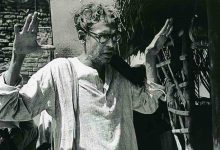Manipur, on the easternmost part of India, bordering with Mynmar (Burma) is a small state having rich cultural heritage and charming landscape; its people are endowed with inborn talents in dance, drama and music; it has a thousand year old history with uniqueness of its own kind.
Manipur had the experience of viewing peep show and magic lantern right from the later part of the 19th century. Mr. Grimwood, Political Agent of the British Colony, himself was a good painter, arranged slide shows for the Princes and the nobles of the palace. From the early part of the 20th century people had the experience of enjoying the Bio-scope which had surpassed all forms of entertainment in the society. However, Manipuris started late to make films of their own as late as 1972. They considered cinema as a part of production of the Western technology and thus was beyond their apprehension. At the same time the rule of the colonial government of the British blunted their sensibility from 1891-1947. However when they joined the select band of film makers in the North East, there was no looking back ever.
Cannes Film Festival stands for superlativeness of both the Festival as well as the film. There is no further questioning about that. It is even regarded a notch higher than the Venice Film Festival which is the oldest of its kind. In the memorable Tous Les Cinemas du Monde (Cinemas of the World) Section in 2007 having viewed not less than in 108 Indian films Sergei Sabezyuski short listed only seven Indian Films – SAIBA (Director : Biju), LAGE RAHO MUNNABHAI(Director : Rajkumar Hirani), MISSED CALL (Director : Mridul Tulsi Das and Subramaniam), VEYIL (Director : Vasantlan), DOSAR (Director : Rituparna Ghosh), DHARAM (Director : Bhavana Talwar) and GURU (Director: Maniram). It must have been a perspiring job – to select 15 out of 108 in the first round and then to shortlist 7 of them finally. As Sergei Sabezyuski had said – “There was no compromise on quality”.
Generally, a country is entitled to one day only to screen their entries, but India was given two days on that occasion. It seems western cinegoers have started warming up to the songs and dances that go inevitably into the making of an Indian film. In truth these songs and dances enable to express the emotions awakening in the viewers’ mind. These seven films were admixture of small and big budget films. The regional and diverse cultural elements must have nestled comfortably deep inside the French viewers’ psyche. Print and electronic media reported in earnest the screening of seven Indian films in Cannes. Sixteen years prior to this, in 1991 ISHANOU, a Manipuri feature film directed by Aribam Syam Sharma was screened in Cannes in it’s the “Uncertain Regard Section”. It was the only film selected that year to represent India not the film of Adoor Gopalakrishnan, Shyam Benegal, Manikaul, Kumar Shahni, Amol Palekar, Mrinal Sen or Jahnu Barua etc. The uncommon phenomenon of a possessed Maibee and the related folk dance movements that made up a holistic cultural presentation, the strong narrative of simple family might have charmed the establishment in Cannes. It was one of the highest honours ever shown to Manipuri film maker and the art of Manipuri film. But there was not a ripple of appreciation in the world of Indian cinema. There was nothing like a wide coverage from the side of the national media and to tell the truth the matter was scarcely reported in the papers. During the 15thAnniversary of the publication of Eastern Panorama held in Shillong, Union Tribal Affairs Minister, P.R. Kinda and Chief Minister of Assam, Tarun Gogoi were made to pour out the hurt in their hearts by saying that the national media intentionally neglected the north east. They did not try to know Manipuri film or they did not want to. But the French had already measured and measured well Manipuri films.
X-Cine Productions (IMAGEE NINGTHEM) happens to be the first ever Manipuri film that got entry in the Panorama of Film Utsav, Kolkata in 1982. In those days the International Film Festival of India was held alternately with the Competition Section in one year under the title “The Film Festival” and Non- Competitive Section the next year under the title of “Filmotsav”. On 7th January, 1982 that year’s Panorama films were screened as Matinee Show in the New Empire Cinema Hall, Kolkata. The attendance consisted of about five or ten foreign delegates, Indian film actor – Amol Palekar, two gate keepers, one or two Festival staff on duty and the two or three persons who had gone there representing X-Cine Productions in that gargantuan cinema house that could accommodate at least fifteen hundred spectators. The director of IMAGEE NINGTHEM, Shyam Sharma did not participate in the Filmotsav. IMAGEE NINGTHEM was in black and white, the inherent technical flaws were extreme…patches of darkness or at best grim resolutions marred the clarity on the whole. The film lacked in clarity of images. Film critics – Derek Malcolm (Great Britain), John Warrington (Great Britain), Eichen Berger (Switzerland) and film maker – Patricia Moraz (Italy) on the other hand claimed this film as “Surprise of the Festival”. The beauty of the film was not affected at all by the technical flaws. Alain Jalladeau who was one of the Festival Co-Directors of the “Festival Des Three Continents ‘82’”, Nantes consisting of Asia, Latin America and Africa films came with his brother Phillip Jalladeau to view new films in the Filmotsav 1982. On 9th January, 1982 the third day after screening of IMAGEE NINGTHEM we that included K. Ibohal Sharma, Producer of the film, Smt. M.K. Binodini, Script writer and myself had a meeting with the two brothers Alain Jalldeau and Philip Jalladeau on the beautiful lawn of Grand Oberoi Hotel, Kolkata. In the course of the meeting, they handed us an Invitation to participate IMAGEE NINGTHEM in the Nantes Film Festival. It was unexpected because such a thing as extending an invitation to participate in another film festival while the present festival was going on is indeed a rare event which may not be seen again in the future also. The three of us did not know how to express our thankfulness. We were overwhelmed with wonder filled joyousness. Alain’s selection proved correct – in the festival des Three Continents, 1982, Nante the Manipuri film IMAGEE NINGTHEM bagged the Grand Prix and happened to be the first of its kind too for India as well.
Indian cinema critics and film buffs usually limit their ken at the Bengal horizon. Any of renowned critics, film scholars as Iqbal Masood, Sunil Kothari, Amita Malik, Chidananda Das Gupta, John Dayal has not mentioned any Manipuri or Assamese film while making individual list of top ten Indian films. Iqbal Masood who writes for the Indian Express as well as the Illustrated Weekly of India, who had also cheered spraying champaign when IMAGEE NINGTHEM won the Grand Prix wrote under the title “Under Western Eyes” in the Festival News of the Film Festival of India, 1985 – “the film IMAGEE NINGTHEM was derivative, reflecting some of the worst features of the rebellious Bengali Cinema”. A French critic retorted to Iqbal Masood’s seemingly fault finding criticism. “My Son, My Precious (IMAGEE NINGTHEM)” conquered Europe by its innocence and exoticism – qualities not impressively visible to the Indian critics …. IMAGEE NINGTHEM which Iqbal Masood mentions and GODAN were considered in India as small insignificant films of no great and abiding interest. For us (Westerners), though they may not be perfect, their interest comes from the fact that they take simple subjects where rapport between the characters is invested, with a much large significance. This is what, in an entirely different way, Pialat, Rohmer and Godard too, are doing……. It appears there is a trend of suppression of smaller states and their achievements by bigger states in India when they start making themselves known in art, in the development of their cultural identity; in short when they make their general identity more fulfilled.
Yves Thoraval, a French writer in his book the CINEMA OF INDIA (1826- 2000) has this to say – illuminating Manipur, a state between Assam and Myanmar, became a Union Teritory in 1956, gained statehood in 1972 (ch.xi, P.438) despite of some indiscrepencies in the historical facts, he says regarding the songs and dances of this land – “its musical and dance traditions, mostly of a religious character, figure among the most beautiful and the most personalized aspects in India”.
Further he writes in details about Manipuri film directors as Aribam Syam Sharma, M.A. Singh, K. Ibohal Sharma, Oken Amakcham etc. as an introduction for them to other foreign readers.
All these are about celluloid films that appeared on the scene about a quarter century ago in Manipur. What could we hope from the Video-Digital films today? When honoured guests seldom come, it is but natural for the host to take away the chairs meant for them.
It is quite disturbing.






Leave a Reply
You must be logged in to post a comment.